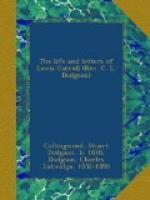Balbus was waiting for them at the hotel; the journey down had tried him, he said; so his two pupils had been the round of the place, in search of lodgings, without the old tutor who had been their inseparable companion from their childhood. They had named him after the hero of their Latin exercise-book, which overflowed with anecdotes about that versatile genius—anecdotes whose vagueness in detail was more than compensated by their sensational brilliance. “Balbus has overcome all his enemies” had been marked by their tutor, in the margin of the book, “Successful Bravery.” In this way he had tried to extract a moral from every anecdote about Balbus—sometimes one of warning, as in “Balbus had borrowed a healthy dragon,” against which he had written, “Rashness in Speculation “—sometimes of encouragement, as in the words, “Influence of Sympathy in United Action,” which stood opposite to the anecdote “Balbus was assisting his mother-in-law to convince the dragon”—and sometimes it dwindled down to a single word, such as “Prudence,” which was all he could extract from the touching record that “Balbus, having scorched the tail of the dragon, went away.” His pupils liked the short morals best, as it left them more room for marginal illustrations, and in this instance they required all the space they could get to exhibit the rapidity of the hero’s departure.
Balbus and his pupils go in search of lodgings, which are only to be found in a certain square; at No. 52, one of the pupils supplements the usual questions by asking the landlady if the cat scratches:—
The landlady looked round suspiciously, as if to make sure the cat was not listening. “I will not deceive you, gentlemen,” she said. “It do scratch, but not without you pulls its whiskers! It’ll never do it,” she repeated slowly, with a visible effort to recall the exact words of some written agreement between herself and the cat, “without you pulls its whiskers!”
“Much may be excused in a cat so treated,” said Balbus as they left the house and crossed to No. 70, leaving the landlady curtesying on the doorstep, and still murmuring to herself her parting words, as if they were a form of blessing—“Not without you pulls its whiskers!”
[Illustration: From a crayon drawing by the Rev. H.C. Gaye.]
They secure one room at each of the following numbers—the square contains 20 doors on each side—Nine, Twenty-five, Fifty-two, and Seventy-three. They require three bedrooms and one day-room, and decide to take as day-room the one that gives them the least walking to do to get to it. The problem, of course, is to discover which room they adopted as the day-room. There are ten such “knots” in the book, and few, if any of them, can be untied without a good deal of thought.
Owing, probably, to the strain of incessant work, Mr. Dodgson about this period began to be subject to a very peculiar, yet not very uncommon, optical delusion, which takes the form of seeing moving fortifications. Considering the fact that he spent a good twelve hours out of every twenty-four in reading and writing, and that he was now well over fifty years old, it was not surprising that nature should begin to rebel at last, and warn him of the necessity of occasional rest.




